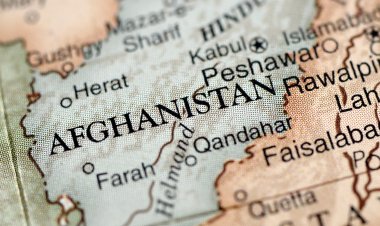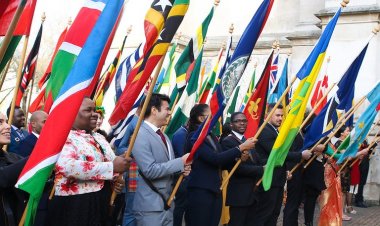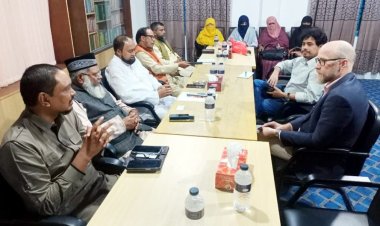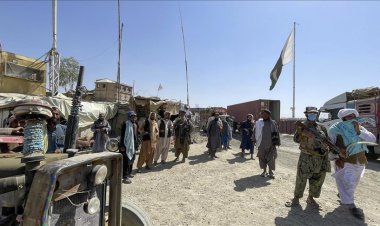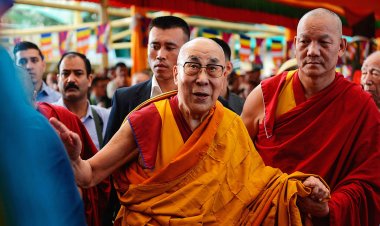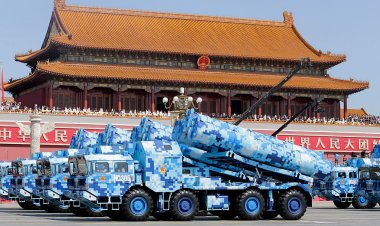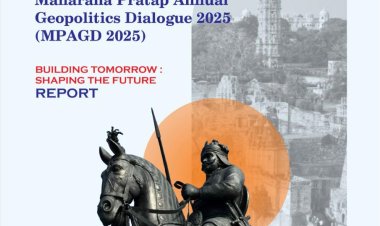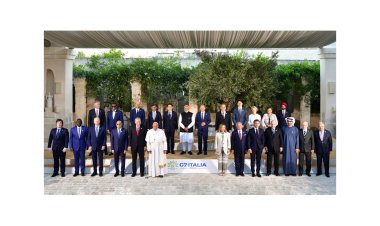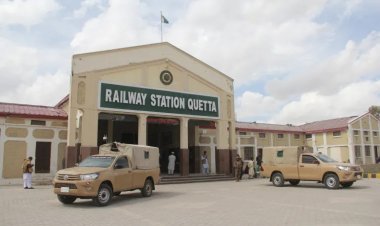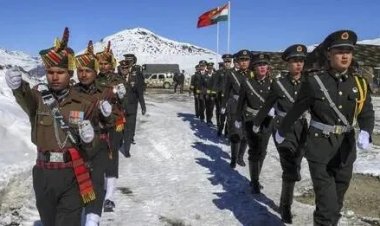Understanding the Role of Spiritual Forces in Making India. Is there a revolution in the offing by the Spiritual forces?
In our recorded history, Sanatan roots are at least 5,000 years old; however, in the spiritual circles, these roots are timeless. What are those forces that prevent this timeless civilization from decay and disintegration and continue to rejuvenate and revitalize it in its new avtars in requirements with the changing times and conditions?
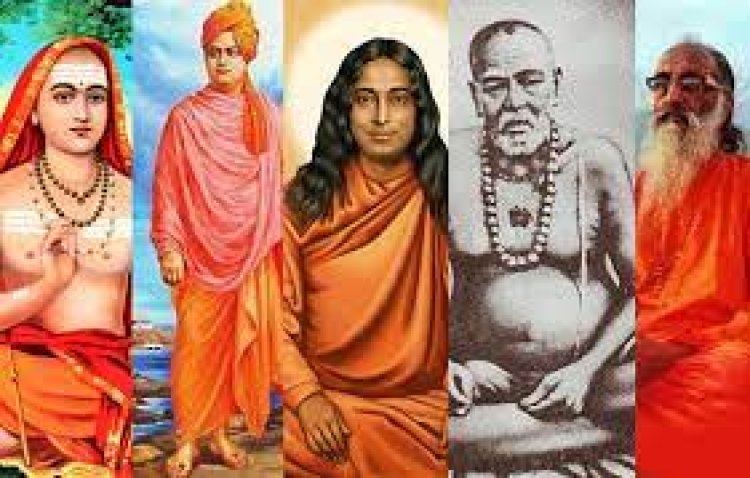
Analysis
By Dr. Abhinav Pandya
Long back in the Nehruvian era, as the anecdote goes, a Soviet delegation with their atheistic beliefs loaded with dialectical materialism, made a trip to India. After their six-month visit, exasperated and puzzled, some of them said that they believed in God. When asked for the reason, they said that in their six-month tour, they found complete chaos, indiscipline, violation of rules, zero commitment to work, corruption, and dysfunctionality in politics and public governance systems, despite which this country continues to move on, thrive, and flourish. Who runs this functional anarchy; perhaps divine agencies!
The truth behind this story may stand to doubt; however, the reason behind mentioning this anecdote is my fundamental quest to explore, reason, and make sense of what runs Bharat, constituting its core i.e., the engine that keeps this ancient civilization relevant. Even the staunch advocate of the two-nation theory and the ideological founder of Pakistan, Iqbal believed that all the great civilizations like Roman, Greek, Egyptian, and Babylonian vanished with time; however, India continues with its civilizational roots and legacy. In our recorded history, these roots are at least 5,000 years old; however, in the spiritual circles, these roots are timeless. What are those forces that prevent this timeless civilization from decay and disintegration and continue to rejuvenate and revitalize it in its new avtars in requirements with the changing times and conditions?
The New Quest for Bharat’s Core
In my undergraduate days at Delhi University, I studied India’s history as researched and explored by Romila Thapar, Sumit Sircar, Vipin Chandra, DN Jha, Mushirul Hasan, Irfan Habib, Nilkantha Shastri, and many other eminent scholars. Most of them were brilliant scholars with robust academic credentials and publications. However, in our history lectures, the emphasis was always on a certain interpretation of history. Often, we heard professors critiquing BB Lal, Jadunath Sircar, and RC Majumdar popularly referred to as historians with the right tilt, with the findings and theories of Marxist historians like Romila Thapar, DN Jha and Sumit Sircar, etc. There were always pre-determined frameworks like generic formulae to understand and narrate history. The most dominant strand has been the Marxist way of analyzing, interpreting, and narrating history. Historians airdropped Theories and research tools employed to understand European history, to understand Indian history, and the evolution of society and culture. Since the Marxist interpretation was in fashion in Western universities, it was considered a lofty ethical duty to superimpose that in India and make sense of, instead complete nonsense of Indian history. In this exercise, the objectivity and dispassionate understanding of history was the biggest sacrifice. Rigorous scrutiny will bring forth the biggest fallacy in this exercise i.e., the foundational epistemology (the theory of knowledge) which constitutes the sources of knowledge. The epistemology in the West has some fundamental differences with the theory of knowledge in Eastern systems. In the West, reason and empirical experience are the two sources of knowledge; however, in the oriental systems, the knowledge revealed intuitively in the deep states of meditative trance constitutes the ultimate and eternal knowledge. The focus of this piece is not the detailed analysis of this fallacy; but it is being discussed here because it led to the complete marginalisation, neglect, and omission of the strongest factor that has shaped Bharat i.e., the spiritual forces.
Sanatana Dharma: Spiritual Forces and India’s Civilisational Journey
If there is any one factor that has the most powerful influence on India’s history across the spectrum of society, politics, art, business, and culture, it is the Sanatan dharmic forces. The spiritual forces have played an instrumental role behind every path-breaking revolutionary phenomenon with lasting influence on society, politics, and culture for thousands of years. Ramayana and Mahabharata, the two epics with the most powerful influence on Bharat’s collective and individual sub-conscious, have two divine entities, Rama and Krishna, both Lord Vishnu’s incarnations, at their centers, as the principal characters. In the spread of Vedic culture across the length and breadth of Bharat, the Brahmins, monks, and ascetics played the most crucial role. The torch-bearers of Sanatan dharma, revered ascetics like Jamdagni, Atri, Vashishtha, Bhardwaj, Vishwamitra, and Pulatsya are said to have established their monastic establishments in densely forested remote parts of Aryavarta and spread the Vedic culture. The Vedic culture reached South India with the efforts of Agastya Rishi, who reportedly blessed Lord Rama with many supernatural weapons. This Vedic culture became the foundation of Bharata/Aryavarta as a Rashtra. The one who ruled the entire Aryavarta came to be known as Chakravartin Samrata.
In India’s written history, the Mauryan Empire, the first centralised and the mightiest empire was established under the mentorship of Kautilya who was an ascetic. During the times of Buddha, India’s socio-cultural landscape was full of seers. Mahavira, Buddha, Carvaka, and Makhkhali Ghosal were blessed with spiritual wisdom and they shared their spiritual insights on the nature of reality, derived from their long and deep meditative experiences. The mighty empires of ancient India like the Guptas, Satvahanas, Chalukyas, Pandyas, Cheras, Cholas, Kushanas, etc. had spiritual entities behind them as a leading inspiration. These spiritual entities became the original source of the unleashing of great social, cultural, political, and economic phenomena in South Asia and beyond. Buddha and Mahavira were great social reformers who spoke against many social ills like animal sacrifices and influenced many influential men of their times including rulers like Chandra Gupta and Asoka Maurya, intellectuals, and prominent businessmen. Notably, Chandragupta became a Jain ascetic towards the end of his life and Asoka adopted Buddhism after the Kalinga war. During Asoka’s reign Buddhist religious and philosophical values constituted the soul of India’s soft power. These dharmic influences reached far and wide. Asoka’s emissaries visited Greece, Sri Lanka, Egyptian and West Asian kingdoms. Asoka, himself visited Khotan in Central Asia in 250 BC. Asokan edicts with Buddhist messages and injunctions have been found as far as Kandahar in Afghanistan. Buddhism grew into an international religion through trade routes and also inspired the world of art and culture. Gandhara Buddhas with Greco-Roman influence and the mighty Bamiyan Buddha statues are a testimony to the overarching impact of Buddhism. Buddhism completely revolutionised the Oriental world, becoming the main religion in Tibet, Myanmar, Thailand, Cambodia, Vietnam, China, Korea, and Japan.
In medieval India, legendary empire builders who fought against the Muslim invaders were inspired by seers and mystics. Bappa Rawal, the founder of Guhila kingdom in Mewar (728 AD), took his inspiration and blessing from Harit Rishi. Bappa Rawal wrested Chittor from Arabs and is said to have chased invaders as far as Iran. Rawalpindi in Pakistan is allegedly, one of the military posts established by Bappa Rawal, on his return journey from Iran. Harihar and Bukka, the founders of the mighty Vijayanagara Empire, were initially converted to Islam, by Muhammad Bin Tughlaq, during his military campaign in South India. They escaped the captivity of the invading Muslim army and took refuge at Vidyaranya and Sayan Rishi’s holy abode near the Tungbhadra river. Sayan rishi brought them back to Hinduism, and they established the Vijayanagar empire. The empire lasted 300 years keeping the surrounding Muslim states under a firm grip and became a flourishing trade and economic centre. Another great hero of medieval India, Shivaji, the founder of Maratha kingdom was a disciple of Samarth Guru Ramdas. Samartha Guru Ramdas was a part of the great tradition of Bhakti mystics in the Maharashtra region that began with Gorakhnath, Gyandev, Tukaram, and Eknath. In most of the stories associated with empire builders and kings, the mention of spiritual master finds a ubiquitous mention. The historicity of such claims may be a subject matter of inquiry however, the idea itself speaks volumes about the role of spiritual forces in shaping India’s history.
Social Reform and Political Movements
Coming to social reform movements, it is pertinent to mention that the religious and spiritual forces played an instrumental role in them. When India was facing an Islamic onslaught in the form of rampant conversions and temple demolitions, there was an overwhelming hopelessness. On the sidelines of military victories, the Sufi saints were converting Hindu lower classes en masse. At this juncture, the Bhakti movement emerged as the paramount force against the advancing Islam. A large number of Bhakti saints such as Pipa, Sen, Dhanna, Tulsidas, Rajjab, Dadudayal, Kabir, Raidas, and Palatdas became the flag-bearers of Sanatan dharma. They revived and revolutionised the Sanatan, defying the caste norms and presenting an egalitarian face of Sanatan dharma. It was a massive social revolution orchestrated and staged by the spiritual forces. They emphasized on caste equality, and simple devotion, condemned ritualism, resolved Hindu-Muslim differences, and preached an inward journey through mediation and devotion where all the duality ceases to exist. With their simple teachings, they rejuvenated Hinduism and arrested the spread of Islam. Many of those saints left a lasting imprint on the subconscious mind of an average Hindu. Till today, Kabir’s bhajans are sung in almost the entire north India and Tulsi’s Ramacharitmanas continue to have the most profound impact on the collective psyche of Hindus. Besides, Sanatan spiritual forces were also working towards the softening and moderation of Islam. The Sufi strain of Islam was deeply influenced by the yogic practices of Nathpanthis, Hathyogis, and the monistic worldview of Vedanta. This softening led to the growth of a joint Hindu-Muslim culture known in common parlance as Ganga-Jamuna Tahzeeb. Till today, there are many shrines worshipped jointly by Hindus and Muslims, Those who converted to Islam, such as Kayamkhani Muslims, Kashmiri pundits, and Mevs, continued many Hindu traditions. The poetry of Khusro, Bodha, Malik Mohammad Jayasi, Raskhan, and many other Sufi saints is full of Hindu imagery and devotion to Radha and Krishna. The Jogis of Mewat, even after their conversion, continued to sing devotional songs in praise of Rama, Krishna, and Shiva. Even today, their first names are after the Hindu gods such as Rama, Lakshman, and Siva.
On one hand, the Sanatan forces were leading a peaceful resistance, whereas, on the other hand, they did not hesitate in taking up arms, if needed. Against the Mughals, Sikh gurus fought valiantly. The spiritual masters became warriors under the leadership of Guru Teg Bahadur and continued the fight under Guru Govind Singh Sahab. Guru Govind Singh ji formed the Khalsa cult and transformed the Sikh peasants into warriors. In Benarus, the militant naga and Nathpanthi monks fought bravely against the Mughal army sent by Aurangzeb to demolish the Kashi Vishwanath temple. Against the British, many subterranean revolts were led by religious leaders and spiritual entities. The Kuka movement (1870s) led by Sikh monks, initially against cow slaughter, turned into an anti-British movement, aiming to overthrow British rule. Other examples include the Sanyasi rebellion (1770-77) of Bengal, primarily led by Dasnami naga Hindu ascetics. Birsa Munda who led the Munda and Oraon tribals against the British rulers of the Calcutta Presidency in the late 19th century, was also a seer, revered as Bhagwan Birsa Munda by the tribal followers. He led the tribal people against British Christian missionaries, forcible conversion, and their land-grabbing practices. Hindu monks and Muslim fakeers also played an important role in the revolt of 1857, as messengers and motivators.
Interestingly, according to some stories, spiritual forces played the main role in the formation of the Indian National Congress (INC), which spearheaded the freedom struggle against the British. Vipin Chandra in his book, “India’s Struggle for Independence,” mentions that a Himalayan yogi Baba Koot Humi Lal Singh impressed AO Hume, the British civil servant by reproducing a copy of the viceroy’s secret letter through his supernatural powers. He told him that the British needed to do something as India was about to revolt on the lines of 1857. AO Hume, alarmed by such predictions, founded INC as a safety valve to give vent to the public angst against the British, through a political organization.
Arya Samaj, the revolutionary social reform movement among the Hindus inspired generations of entrepreneurs and completely revolutionised the religious space of the Hindu middle class. Its founder Maharshi Dayanand Saraswati waged the most powerful and effective ideological counter-narrative against Islamic extremists and led Shuddhi (purification) and Sanghthan (conversion) movements to bring back converted Muslims to the Hindu fold. Swami Vivekananda who enthralled the Western audience with his mesmerising speech about oriental religions in the World Parliament of Religions in Chicago (1897) and had a very powerful imprint on the minds of Hindu youth was a Hindu saint and disciple of Rama Krishna Paramhansa, a great devotee of Goddess Kali. The trio of Rama Krishna Paramhansa, along with Maharshi Dayanand Saraswati and Swami Vivekananda have the most powerful influence on modern-day Hinduism in India. During the non-cooperation movement (1920-21) several micro-level variants of that movement started in various parts of India in which religious leaders played a key role. Sitaram Baba led the Bedakhal (Eviction) movement against rapacious land revenue practices of the British in eastern UP. Alluri Sitaram Raju, who waged a guerilla war against the British in 1924, leading the Rampa rebellion was also a Hindu ascetic. Initially, as a sanyasi, he began his tirade against conversions by the Christian missionaries. His popularity as a charismatic sanyasi won him thousands of followers who believed in his invincibility. Notably, Gandhi’s connect with the masses transforming him into a larger-than-life phenomenon is also largely due to his image of a pious ascetic, a Mahatma. Had he projected himself as a politician, his stature would have been diminished long ago. Several Arya samaj monks like Swami Shraddhanand and Swami Sahjanand Saraswati played a crucial role in in anti-British struggle and agrarian movements.
In the post-independence period, enlightened Indian spiritual masters like Paramhans Yogananda, Maharshi Mahesh Yogi, Swami Narayan Sansthan, Satya Sai Baba, Osho Rajneesh, Sri Sri Ravishankar, Jaggi Vasudev, etc. carried the message of yoga and meditation to the western world. The kind of following these modern-day spiritual masters have, makes them parallel kings of an undefined territory and unspecified constituency of followers. In foreign lands, they are the most credible carriers of India’s soft power. The institutions like Swami Narayan Sanstha not only have a presence in more than 100 countries, but they have also done excellent work in public service and humanitarian relief in Gujarat, that can challenge even the most effective and advanced public delivery systems and governance.
In domestic social scenario, Tembe Swami Maharaj, Loknath Tirtha Swami, Gulwani Maharaj ji, Prabhu Baa, Swami Shivanand, Dongre Maharaj, Muktanand Ji, Raman Maharshi and last but not least, Gita Press of Gorakhpur have staged massive silent social revolutions inculcating crores of devotees into the path of meditation. If they desire, in politics, their one word can drastically alter the contours of the elections and the fortunes of big leaders. Most recently, Bageshwar Dhaam swami ji is awakening the Hindu society about the Hindu Rashtra at lightning speed. Swami ji’s fearlessness, the number of followers in his congregations and their passion almost look like a supernatural phenomenon. Interestingly, the right-wing Hindutva organisations have been working for the last 100 years on the Hindu Rashtra; however, they could never get a following even one-tenth of what Swami Bageshwar dham is getting. Also, the ordinary people found their discussions and explanations of Hindu Rashtra very confusing, timid, and defensive as if their sole mission is not to offend anyone. As a last resort, when it becomes impossible to sustain the argument, their Hindu Rashtra becomes a cultural notion.
Even in political quarters during the Congress regime, known for its anti-Hindu stance, spiritual masters have played a crucial role in guiding the political leaders. Dhirendra Brahmachari mentored Indira Gandhi, Rajiv Gandhi, and the VHP leaders often met Devraha Baba of Mathura, a yogi who reportedly lived for 900 years! during the Ram temple movement. Chandraswami, a tantra expert was a close confidante of PM Narsimha Rao. In every district of India, the local politicians, police officers, and civil servants maintain close links with saints and monks and seek their counsel on crucial administration-related matters. Today, Yogi Adityanath, head of the age-old Nath Panthi sect rules UP as a Chief Minister. Is it not surprising that without any experience and high-flying degrees from Harvard and Cambridge, the monk displays an exceptionally impressive control over state affairs including India’s notoriously arrogant and status-quoist bureaucracy? He has not only brought a sea change in one of the worst law and order situations but also brought the state economy in shape with most of the PSUs registering profits.
Amongst all the 20th and 21st-century Sadgurus of India, Osho Rajneesh had almost staged a coup in the Western world. With his message of meditation and humanism, he became immensely popular in the West, almost a revolutionary figure, and came to be perceived as a great threat by the Christian clergy and the state, in the West. Even in Modi’s thumping 2014 victory, the role of Baba Ramdev, a Hindu monk better known for his work in revolutionising yoga and Ayurveda, has not yet caught the attention it merits, from the scholars of political science. The RSS has been in existence for almost 100 years now, working on the grassroots and propagating its Hindutva message. However, the RSS and other right-wing political, social, and cultural outfits could never find that all-encompassing connect with the masses and unflinching followers with commitment because in popular perception they lacked the spiritual essence. However, religious men like Baba Ram Dev could accomplish that connect because of the sheer power of religion over the minds of the people. Baba Ramdev with his accomplice, Rajeev Dixit, was organising yoga camps across the country, including the remote areas as far as Arunachal Pradesh, where he openly spoke about India’s ancient glories and achievements in the past. Blaming the British and the ruling regimes that followed the departure of the British for their anti-Hindu, pro-Islamist, and anglicised policymaking, he created a robust anti-Congress narrative on the pillars of corruption, Islamist appeasement, pro-western attitudes and anti-Hindu policies. Finally, this was followed by a series of scams, bomb blasts, and the Congress-led UPA government’s failure to address these challenges. The last nail in the coffin was the lathi charge ordered by Chidambaram’s home ministry on Baba Ramdev, peacefully protesting against corruption with his supporters. The brutal and horrifying episode reminding one of the Chekha police or Gestapo, left a deep-seated resentment and grudge in the hearts of Hindus because a Hindu monk was beaten, thrashed, and humiliated for no crime of his. The episode signaled that the Congress party had an inherent hatred for Hindus and that their future was not safe in the Congress rule. That episode reminded the Hindu common folk of the police firing on Hindu monks protesting against cow slaughter during the Indira Gandhi government after which, reportedly Karpatri Maharaj, a revered Hindu monk cursed Indira that she and his family would meet a political decline and ruination. Not to lend any scientific credibility to the monk’s curse; however, the final outcome of this episode was more than evident in the election results of 2014.
Monks, Mysticism, and Science
I must admit that my knowledge of the history of science and technology is very limited. Here, the purpose is not to discuss the long list of scientific inventions and discoveries in ancient India; however, I wish to drive home a different point of view. Ancient India’s history is full of monks devoted to spiritual practices making great scientific discoveries. Nagarjuna, a Buddhist monk propounded the theory of relativity and was a great alchemist. Aryabhatta, Charak, Dhanvantari, Bhaskaracharya, Varahmihira, Kanad, and several other scientific luminaries were ascetics and monks. The six schools of Indian philosophy, Nyaya-Vaisheshika, Sankhya, Vedanta, Jainism, Buddhism, and Carvaka, were not propounded by trained metaphysics or professors of philosophy, but by the sages, monks, and mystics. Ashtavakra Gita, a treatise on the nature of reality was given by a mystic, Ashtavakra. The ancient Salvasutras have great hidden treasures of trigonometry and Maths. Allegedly, even the discovery of zero or Shunya is traced to the meditative state of Samadhi where sages experience the state of Shunya. Buddhism has a complete school on Shunyavaad. In the East, mysticism and science were not seen in a compartmentalized manner, and opposed to each other. The knowledge was seen as complete and unitary. Unlike in the West, where reason, empiricism, and a very basic level of intuition constituted the key pillars of the theory of knowledge; the East recognized the limitations of the ordinary/natural sensory perceptions. The seers in India believed that to comprehend reality as a whole the wisdom, insights, and the visions revealed in the deep states of meditation are the ultimate source of knowledge.
Conclusion
Even in today’s India when these spiritual forces have no official presence in the constitution, state institutions, and structures, their hold and influence on the ground in social matters are paramount. These saints attract lacs of devotees. Even the most corrupt, hubristic, and indolent government officials become hard honest, and efficient in the ashrams of their Gurus. Mocking the constitution, flag or a national-level political leader will not drive masses into rage; however, insulting or harming a monk/ascetic or a divine figure can lead to riots and killings. People’s sense of identity predates India which underwent the transfer of power in 1947. Their loyalties towards ancient spiritual and religious structures, monastic institutions (akahdas), and individuals are much more profound and stronger. It's embedded deep in their subconscious mind. Imagine a country where shraddha which is mentioned in Ramayana and Mahabharata continues to be one of the most important religious practices till today, even after 7000 to 8000 years. In other civilizations, they made 180-degree changes by adopting Christianity and Islam but in India, history is alive.
The most unfortunate part is that the current system of governance, civil service, security, police and intelligence, education, economy and welfare, and politics is totally bereft of India’s spiritual roots and legacy. This is a distorted and moth-eaten leftover of what the British created for the needs of their colonial empire. Motivated by the Western theories of separation of Church and State, which was purely a product of the Western medieval history of the Church-State conflict, the UK-trained lawyer-politicians of the Indian freedom movement who drafted the constitution, instead extracted 85 % of it from the Government of India Act 1935 and rest from various western nations, nurtured an unreasonable bias and in many cases abhorrence towards India’s Sanatan traditions and institutions. The anglicised civil service which we inherited from the British had no moorings in Sanatan roots. The hatred was to such an extent that the first PM of India JL Nehru completely distanced himself from the reconstruction of Somnath temple, the symbol of India’s spiritual legacy, which was looted by Mahmood Gaznavi in 1025 AD. As a result, the Sanatan legacy in law, history, education, statecraft, economy, sciences, and philosophy, along with the world’s oldest language Sanskrit were rejected and dumped as superstitions and dogma. Over time, the intellectual and academic exercise in universities and think tanks was to portray the Sanatan legacy and history as anti-science, caste-ridden, oppressive, anti-females, Dalits, tribals, and minorities, fanatic and anachronistic, and whitewash the minds of the future generations with an absolute hatred against them. The foreign invaders who tried their best to destroy the Sanatan legacy in the most barbaric and brutal manner came to be portrayed as progressive and saviors of humanity. Ridiculous and absurd arguments were framed to defend their acts of temple destruction and forced conversions.
However, the intellectual and policy elites do not realise that the root causes of India’s present-day major ills and roadblocks in governance, security, economy, diplomacy, and education are ones that predate the arrival of the Mughals and the British. In fact, the corruptions and disruptions in our indigenous strategic culture and thought, religion, philosophy, and governance practices paved the way for the arrival of the foreign Islamic and later European invaders and facilitated their plundering. Hence, if we find solutions in the practices, beliefs, theories, and policies crafted and created in the Western world and loaded with colonial baggage, then we will never find solutions to our problems. For example, our attempts to address caste-related discrimination and grievances with divisive quota regimes, once again a product of colonial legacy, have ended up aggravating the caste fault lines and animosity. Likewise, we have completely ignored our Sanatan scriptures and theories in finding answers to our security, intelligence, and diplomacy-related challenges. Not only this, we have become overly obsessed with foreign ideological constructs like Marxism, democracy, human rights, secularism, feminism, etc. and we continue to superimpose them on the Indian landscape, a wounded civilisation that predates development and evolution in Europe by a huge gap. Previously, the sages guided the kings and ministers on governance, security, and state-related matters. In education and justice, they had the final say. We have thrown those traditions and practices into the trash, a civilisational legacy of thousands of years, worthy of a paramount. respect.
Despite the outward sheen and shine of the big-ticket G20 celebrations, and loud brandishing of the government’s so-called achievements in economy and national security, it is clearly evident that our systems have failed, be it bureaucracy, academia, or the security set-up. With all the tedious and rote-learning academic systems, we have produced third-rate academics, incompetent, self-seeking, corrupt, hubristic, and average bureaucrats whose skills, ethics, integrity, and knowledge pale into insignificance as compared to their Western counterparts. Our political class comes out as the biggest enemy of our civilisation and country with their abysmally poor knowledge of Sanatan values and scriptures, shallow morals, and almost nil commitment to our Sanatan ideals, philosophy, and practices.
India’s biggest challenge, an existential threat today is radical Islam and its fast-spreading tentacles, leaving aside the threats and challenges from the foreign powers. And, with five plus years of experience in security and public policy, I can confidently state that the current brass of bureaucracy, judiciary, academia, politicians, and the security czars hardly seem to have even a bare minimum understanding of the above-mentioned challenges, leave aside giving effective policy solutions. They have failed miserably because they are not only disconnected from their Sanatan roots but also full of abhorrence for their roots and past. Born and raised in a Westernized, colonial socio-cultural milieu and borrowed education systems of the West, they feel ashamed of owning their past and identity. I feel this every day in my routine interactions with Indian army officers, diplomats, professors, and civil servants. In most of my office interactions with them, they begin the conversation in heavily accented-thick English. Their general attitude towards mystics and rishis is of mockery. Their children study in Western universities, listen to Western music, watch foreign movies, and are ashamed of even speaking in Hindi; Sanskrit is a far cry. Their normal conversations in their homes are in English. The newer generation of civil servants seems more interested in showcasing their chiseled bodies, sex appeal, and vulgar outfits in cheap thrills like Instagram reels. These so-called colonial masters are nothing more than colonised robots who are knowingly or unknowingly serving the agenda of the anti-India Islamist and Western forces.
Even the so-called Hindutva organisations lack the spiritual backbone and have extremely poor knowledge of Sanatan philosophical schools, history, and scriptures. I have not yet come across even 10 to 15 strong scholars of Sanskrit and Indian philosophy in the Hindutva cultural and political groupings. They have not published any rigorously researched articles and papers in reputed journals. Even their basic inspiration is also from the West. Confined to rhetoric and suffering from poor intellectual standards, they exude an inferiority complex, and lack of confidence, and go to extreme lengths to compromise and please the left. When asked to bend, they prefer to crawl. Their ideologues and cadres manning the universities and think tanks have not only become vulnerable to the vices of power, corruption, and women but also peddle the same narrative and intellectual discourse that any ‘run-of-the-mill’ and substandard center-right or center—left think tank would do. Their approach and thoughts on Islamic extremism are increasingly wallowing into appeasement and sycophancy that emanates from fear, fatigue, ignorance, and fast-drying commitment to ideology.
So, what happens next? Something has to happen because things are collapsing fast. The institutions are crumbling, having outlived their utility. If the current state of affairs continues, maybe the Sanatan civilisation and current secular-democratic India will cease to exist, giving way to a Sharia-dominated system and this change can happen even faster than one expects. One look at the pernicious spread of radicalisation, the spread of communal violence, dysfunctional state institutions, and incompetent and opportunistic politico-bureaucratic class is enough to make a perceptive mind realise the gravity of the situation.
However, if one goes by India’s history, it can be reasonably argued that the Sanatan civilisation is eternal and continues to survive, saved time and again, by spiritual forces through revolutionary interventions and struggles. One revolution came in 2014, which completely uprooted the older socio-political set-up and culture that dominated India for seven decades. Perhaps, another revolution is in the offing and once again the spiritual forces will be the key drivers, controllers, and leaders of that phenomenon. However, this time, one may witness a lot of blood-shed on the streets in this Dharmayuddha to salvage Sanatan, because the state has failed.
As I witness the policemen running from the riot sites with the AK 47 slinging on their shoulders, chief ministers giving cowardly defense statements and appeals to maintain peace, and dishonest intellectuals peddling false doctrines of a backside in Indian democracy and the rise of Hindu extremism, I feel more and more convinced about the inevitability of this upcoming violence.
Last but not least, it is pertinent to mention that even the spiritual-religious ecosystem of Bharat has gone through trials and tribulations, in the face of incessant invasions of Abrahamic faiths, foreign invaders, temple destructions, forced conversions, and anti-Sanatan state policies after India’s independence. Over the last millennia, they have lived and survived in crises and fear. Such pressures led to several distortions, corruptions, infightings, decline in inner strength, chivalry, and purity and the religious leaders and institutions becoming weak, under-confident, and vulnerable to politically and financially powerful entities. Their marginalization and suppression have also brought in the greed and lust for power and proximity to politically influential people. Hence, the Sanatan religious ecosystem itself is also in need of transformation and rejuvenation. However, the silver lining is that, even in the midst of severe crises and pressures the Sanatan never faded into extinction and was always protected, revived, and re-energized by enlightened spiritual masters like Gyandev, Ramanand, Tulsidas, Osho Rajneesh, Shri Lahiri Mahashay, Yukteshwar Giri ji, Tailang Swami, Paramhansa Yogananda, Ramakrishna Paramhansa, Maharshi Dayanand Saraswati etc. The mechanism is internally driven; hence it is highly likely that the leadership of upcoming transformation and evolution will be taken by the religious forces, like it always happened in the past.
Disclaimer: This paper is the author's individual scholastic contribution and does not necessarily reflect the organization's viewpoint.


